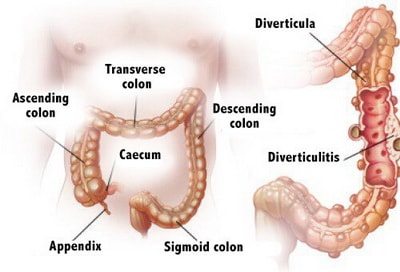What is Diverticulitis?
 What is Diverticulitis? Diverticula are pouches on the outside of the colon. This condition is known as diverticulosis, which can develop into diverticulitis when a diverticulum becomes inflamed.
What is Diverticulitis? Diverticula are pouches on the outside of the colon. This condition is known as diverticulosis, which can develop into diverticulitis when a diverticulum becomes inflamed.
Diverticulitis is a common disease of the colon that is often caused by a lack of fiber in the diet. This disease produces symptoms that are common to many other digestive disorders.
The primary challenge in identifying what is diverticulitis typically involves differentiating it from other conditions.
Patients with diverticulosis often do not have any symptoms, although some patients may experience bloating, constipation and slight abdominal cramps. These symptoms are not specific to diverticulosis, and may also be caused by ulcers and inflammatory bowel disease.
Diverticulitis Symptoms
The most common symptoms that indicate diverticulosis has progressed into diverticulitis include pain in the lower left quadrant of the abdomen, fever and an elevated white blood cell count. Diverticulitis can also cause constipation, diarrhea, and nausea.
The sigmoid colon is on the left side of the abdomen and is the most common location of diverticulitis. People who want to know what is diverticulitis must understand that the pain from this disease may also originate from the lower right quadrant on rare occasions.
The severity of symptoms that occurs when diverticulosis develops into diverticulitis can vary greatly, according to the complications and the spread of the infection.
The most common progression of symptoms consists of slight pain and diarrhea early in the day that develops into sharp and vomiting at the end of the day.
Diverticulitis Cause
The immediate cause of diverticulosis is currently believed to be elevated pressure within the colon, known medically as the intraluminal pressure.
The sigmoid colon is the smallest part of the colon, which means the intraluminal pressure is highest in the sigmoid colon. People who want to know what is diverticulitis should realize the sigmoid colon is most likely to have diverticulosis.
Current medical research supports the claim that insufficient dietary fiber causes high intraluminal pressure.
Diverticulitis must be differentiated from other diseases of the digestive tract. Diseases that often produce symptoms similar to diverticulitis include irritable bowel syndrome, colon cancer and ischemic colitis. The issue of what is diverticulitis must also distinguish between this disease and gynecological or urological problems.
Diverticulitis Diagnosis
Computed tomography is the most common method of determining what is diverticulitis. CT is an imaging method that uses X-rays to examine soft tissue and is able to diagnose diverticulitis with 98 percent accuracy.
This procedure typically requires the patient to ingesting a dye that will provide contrast between the colon and surrounding tissue.
The CT scan usually consists of transverse images of the patient’s abdomen taken at 5mm intervals. The radiologist examines the digestive tract for diverticula, particularly in the area from which the symptoms are originating. Complications of diverticulitis such as an abscess may also be visible on the CT scans. The CT scan is often used to drain abscesses caused by diverticulitis.
Additional studies used to diagnose what is diverticulitis include colonoscopy and a barium enema.
A colonoscopy is the examination of the colon with a camera attached to a flexible cable known as an endoscope. A barium enema is a study that involves filling the colon with barium sulfate and taking X-rays of the colon.
These procedures are invasive and carry the risk of perforating the bowel. They are therefore contraindicated in cases of acute diverticulitis.